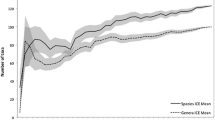Abstract
Numerous invasive aquatic species introductions can be traced to the aquarium trade. Many potentially harmful aquarium species may be difficult to identify based on morphology alone. As such, some prohibited or invasive species may be available for purchase if they are mislabeled as species without restrictions. Here we compare molecular identifications to internet vendors’ identifications for accessions of a popular genus of aquarium plants that are difficult to distinguish morphologically (Myriophyllum; watermilfoils). Specifically, we identified the extensive mislabeling of M. heterophyllum—an invasive species in the northeastern and western US. Furthermore, genotypes of M. heterophyllum found in our aquarium survey have also been found in invasive populations, suggesting their potential introduction through escape from aquaria, water gardens, or nurseries. Two additional taxa were sold under incorrect names. Finally, our survey revealed that Myriophyllum taxa present in the aquarium trade generally have poorly known distributions and ecologies, and therefore their invasive potential is unknown. Our study confirms that molecular identification methods can provide a valuable tool to survey commercial pathways for potentially harmful species that are otherwise difficult to identify.


Similar content being viewed by others
Notes
Vendors were located in Florida, Ohio, Pennsylvania, Michigan, Wisconsin, Minnesota, South Dakota, and Arizona.
ITS and trnK 5′ alignments are provided as supplementary material.
Comparison of our ITS sequences to those by Moody and Les (2010) is available as supplementary material.
Comparison of our trnK 5′ sequences to those by Moody and Les (2010) is available as supplementary material.
Comparison of the phylogenetic positions of M. sp. red1 and M. sp. red2 to the vendor species names can be seen in Fig. 1.
References
Aiken SG (1981) A conspectus of Myriophyllum (Haloragaceae) in North-America. Brittonia 33:57–69
Cohen J, Mirotchnick N, Leung B (2007) Thousands introduced annually: the aquarium pathway for non-indigenous plants to the St Lawrence Seaway. Front Ecol Environ 5:528–532
Holsbeek G, Mergeay J, Volckaert FAM, De Meester L (2010) Genetic detection of multiple exotic water frog species in Belgium illustrates the need for monitoring and immediate action. Biol Invasions 12:1459–1463
Le Roux J, Wieczorek AM (2009) Molecular systematics and population genetics of biological invasions: towards a better understanding of invasive species management. Ann App Biol 154:1–17
Lodge DM, Williams S, MacIsaac HJ, Hayes KR, Leung B, Reichard S, Mack RN, Moyle PB, Smith M, Andow DA, Carlton JT, McMichael A (2006) Biological invasions: recommendations for US policy and management. Ecol Appl 16:2035–2054
Mills EL, Leach JH, Carlton JT, Secor CL (1993) Exotic species in the Great-Lakes—a history of biotic crises and anthropogenic introductions. J Gt Lakes Res 19:1–54
Moody ML, Les DH (2002) Evidence of hybridity in invasive watermilfoil (Myriophyllum) populations. Proc Natl Acad Sci USA 99:14867–14871
Moody ML, Les DH (2010) Systematics of the aquatic angiosperm genus Myriophyllum (Haloragaceae). Syst Bot 35:1–19
Orchard A (1986) Myriophyllum (Haloragaceae) in Australasia. II. The Australian species. Brunonia 8:173–291
Padilla DK, Williams SL (2004) Beyond ballast water: aquarium and ornamental trades as sources of invasive species in aquatic ecosystems. Front Ecol Environ 2:131–138
Paquette A (2008) The aquarium plant trade: missing pieces. Front Ecol Environ 6:123–124
Reichard SH, White P (2001) Horticulture as a pathway of invasive plant introductions in the United States. Bioscience 51:103–113
Stam WT, Olsen JL, Zaleski SF, Murray SN, Brown KR, Walters LJ (2006) A forensic and phylogenetic survey of Caulerpa species (Caulerpales, Chlorophyta) from the Florida coast, local aquarium shops, and e-commerce: establishing a proactive baseline for early detection. J Phycol 42:1113–1124
Tamura K, Dudley J, Nei M, Kumar S (2007) MEGA4: molecular evolutionary genetics analysis (MEGA) software version 4.0. Mol Biol Evol 24:1596–1599
Thum RA, Lennon JT (2010) Comparative ecological niche models predict the invasive spread of variable-leaf milfoil (Myriophyllum heterophyllum) and its potential impact on closely related native species. Biol Invasions 12:133–143
Thum RA, Lennon JT, Connor J, Smagula AP (2006) A DNA fingerprinting approach for distinguishing native and non-native milfoils. Lake Reserv Manage 22:1–6
Thum RA, Zuellig MP, Moody ME, Johnson RL, Vossbrinck C (2011) Molecular markers reconstruct the invasion history of variable leaf watermilfoil (Myriophyllum heterophyllum) and distinguish it from closely related species. Biol Invasions 13:1687–1709
Walters LJ, Brown KR, Stam WT, Olsen JL (2006) E-commerce and Caulerpa: unregulated dispersal of invasive species. Front Ecol Environ 4:75–79
Acknowledgments
We thank Caleb James, Heather Schellie, Heather Hayward, Patricia Phillips, and Matthew Zuellig for laboratory assistance. Colleen Lyon provided valuable assistance obtaining early taxonomic treatments of Myriophyllum. Three anonymous reviewers provided helpful comments that improved the manuscript. We also thank Ann Bove, Jen Parsons, and Amy Smagula for helpful conversations throughout the development of this project, and the Thum lab group for comments on an early draft of this manuscript. Funding for this project was provided by National Science Foundation grants to RAT (DEB-0918553 and DBI-0922591), including a National Science Foundation Research Experiences for Undergraduate supplement for ATM.
Author information
Authors and Affiliations
Corresponding author
Electronic supplementary material
Below is the link to the electronic supplementary material.
Rights and permissions
About this article
Cite this article
Thum, R.A., Mercer, A.T. & Wcisel, D.J. Loopholes in the regulation of invasive species: genetic identifications identify mislabeling of prohibited aquarium plants. Biol Invasions 14, 929–937 (2012). https://doi.org/10.1007/s10530-011-0130-8
Received:
Accepted:
Published:
Issue Date:
DOI: https://doi.org/10.1007/s10530-011-0130-8



